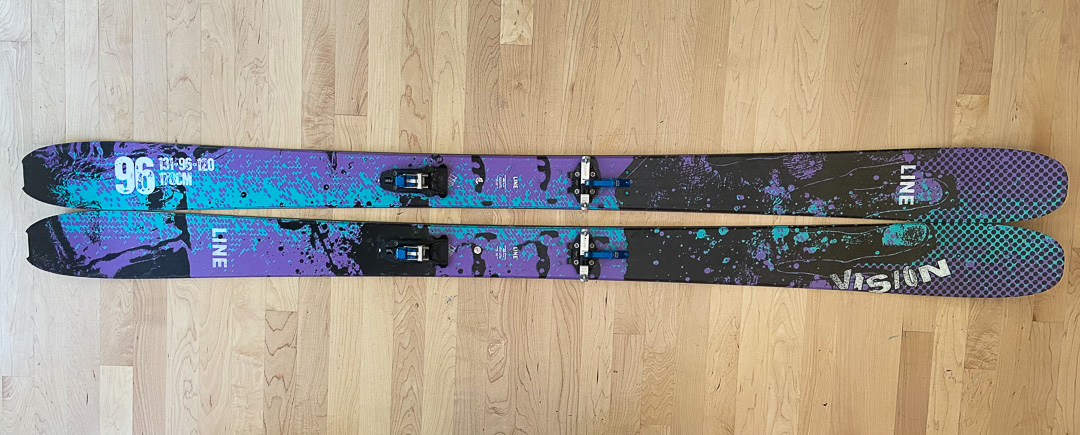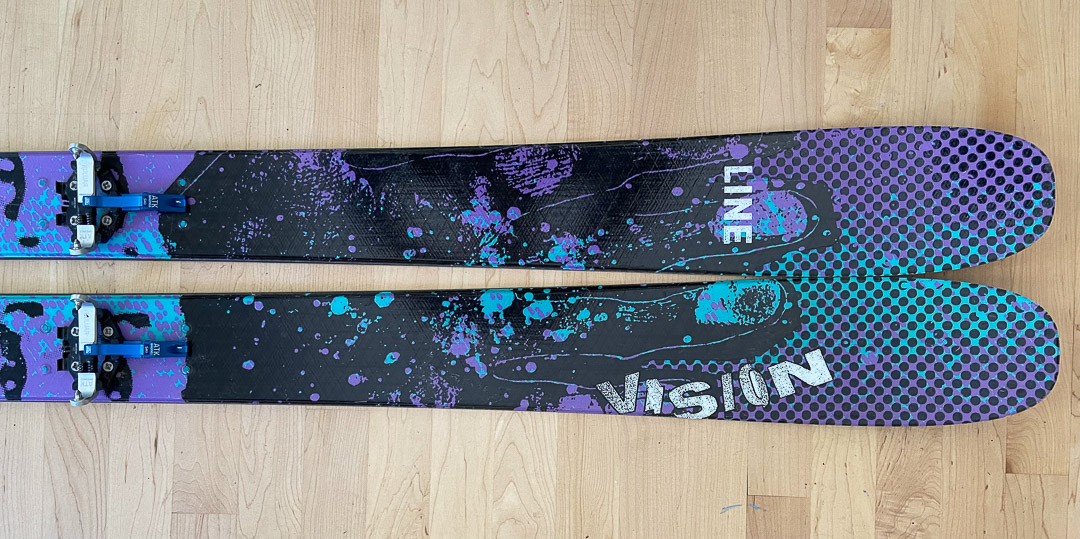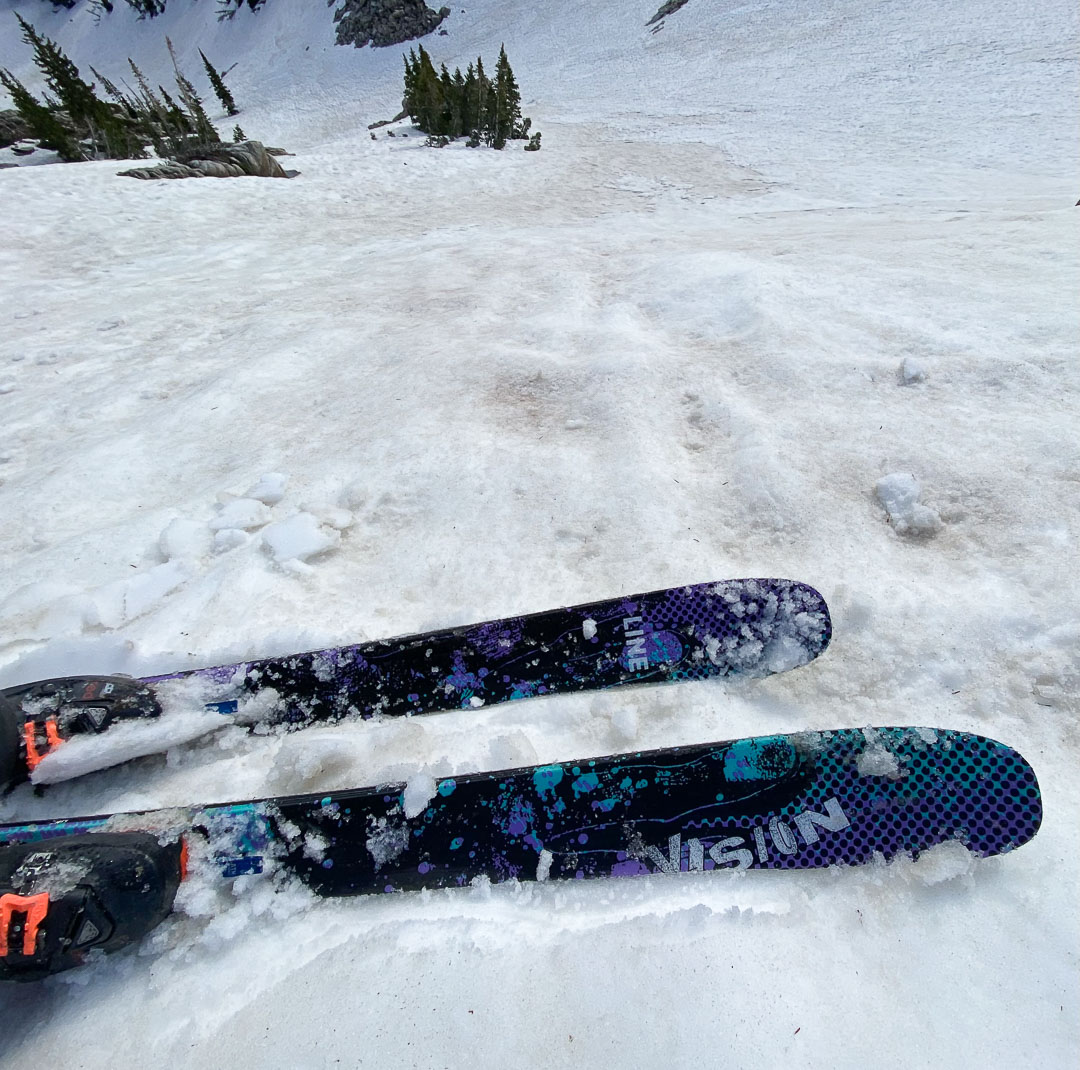You know that place where you’ve had just enough beer to be really good at pool? That’s where Line’s Vision 96 lies. Just drunk enough to be loose and confident but sober enough to sink the next four shots in a row. It’s a hard place to stay—right in that pocket. The sweet spot.
The 2025 Vision 96 is a highly capable ski that balances low weight, stability, dampness, and playfulness. Who will like these skis, and when? Consider these skis if you want to tour a long way but are unwilling to go full chatter stick. Like to seek hero corn but will undoubtedly encounter snow of an unruly nature. Will enjoy making some jump turns down the steep and narrow, but also want to open it up and get the wind in your hair. At 1618g/ski, these are not your sober, ultra-light, carbon euro ski. Nor are they a near-in-bounds-weight beer can crusher. The Vision 96 is the tuxedo tee-shirt. It likes to be formal but is also here to party (credit due to Cal Naughton Jr for that line).
Continue reading for a more in-depth review, including the kind of numbers and details one should expect from a top-notch review site such as this, as well as a dive down the rabbit hole into Situationist art, Marxism, punk rock, and a clear-headed argument for Anarchy.
***
In the new Vision 96, Line has made a big departure from the previous Vision 98. It has gained a little weight: one king-sized Snickers bar per ski and some stiffness throughout. The original Vision was heralded as light and playful but lacking the backbone you’d want for harder, rougher and rowdier. The new Vision brings a lot more security for difficult terrain and conditions but maintains what makes a Line ski a Line ski. It’s fun.


The freeride selections of Line skis have evolved by mating the best aspects of the lighter Vision with the more in-bounds oriented Blade Optic collection. But what does that even mean, and how does it impact how a ski is designed? Line skis originator, Jason Leventhal, was at the forefront of modern skiing and ski design. His designs, and Line’s origin as a ski company, come from the freestyle side of skiing. Jibbing, hucking, flying through the air, down rails, doing tricks. Baggy pants. And while none of that might appeal to you, it has impacted ski design and changed skis and skiing forever, and for the better, even for those in very tight pants.
Freeride skiing combines the playful nature of freestyle with skiing natural, all-mountain terrain. Think the Freeride World Tour, skiing committing terrain in mixed conditions in creative ways, and throwing in the aforementioned hucks and tricks at high speed. If you don’t know what I’m talking about, check out Line’s athlete, Ben Richards.
The Vision 96 brings a nice balance of attributes. It is relatively light. It is quite capable, and by that, I mean stiff enough with a long enough turn radius to handle hard snow and steep terrain. It is damp enough to enjoy some rough snow and survive really harsh conditions. It is stable enough to let’er run fast, stable enough to land some (sweet) jumps. It has enough tip and tail rocker, low camber, and is soft enough to be playful and maneuverable.
Freeride skis, then, are a balance of damp, stable, maneuverable, and playful. And hell no, I don’t ski like I’m on the Freeride World Tour, and few of us do. But it alludes to the versatility achieved with that kind of ski, and specifically this ski. It is a combination where one person might say, “I like how damp they are for staying in control on rougher snow, and I like how easily maneuverable they are in places I want to make reliable, precise, and controlled turns.” And referring to the exact same attributes, another person might say, “I like how stable they are for landing jumps, for rocketing down stuff, for not loosening my fillings while pointing it over harsh snow, and I like how playful they are for spinning tricks, and using natural terrain as a playground.” So, in that way, the benefits of a freeride based ski can be looked at in two different ways. The lines, so to speak, are blurred here.
Getting Granular
In the case of the Vision 96, as a backcountry freeride ski, it is a lighter, more rockered version of the Optic 96—which is an inbounds freeride ski. Leventhal left Line long ago, but the current design team still designs the kind of skis they like to ride without respect for tradition. I got a hold of Line ski designer Sean Fearon to get more info about the Vision 96. He had just returned from skiing the Fuhrer Finger on Rainier on the 96 and felt like the trip was a cool way to sign off on the new build. According to Sean, the Vision 96 has replaced the metal of the Optic with a new version of their Triple Hybrid Camber, which now includes carbon, fiberglass and flax. Only one of them is good in muffins, but all are lightweight, and supposedly, they all resonate at different frequencies, thus smoothing the ride. Picture three uniquely blissed-out people at a Wide Spread Panic show—definitely all dancing in their own way to the beat of the same drummer. In keeping with that analogy, they call this layup THC 2.0. So not only is it more damp, it’s also more dank.
Check out flax as a building material. What they’re doing with it is pretty cool. The Forest Stewardship Certified wood core is a combo of Aspen and Paulownia, which is a common touring ski layup. They also use bio-resin, thus achieving a more environmentally friendly construction.
The closest ski I have used to the Vision 96 is the 2022 DPS Pagoda C94, a ski I loved for spring conditions. On hard snow and good corn, both are excellent skis—the DPS is lighter and has a longer traditional camber and a slightly longer radius than the Vision. Both have good edge hold and are quite maneuverable skis, especially compared to more traditional skis such as a Zero G lineup. Since returning them to DPS, the C94 was a ski I wished I still had, but the Vision 96 might be an even better fit. The Vision has a lower camber and is actually pretty stiff, especially through the midsection. It has a bit of tip rocker and a long, low rocker in the tail. Skiing flat or with less edge angle, they pivot easily. Get them up on edge, and you have a very secure ski, and a damn fine carve even in less than Goldilocks conditions.
The low camber and long subtle rocker of the Vision’s tail reminds me of the 4FRNT Raven, a fully rockered and very stiff ski. Even though they are quite different, there are some similarities between them. The Raven, too, is an excellent and versatile ski. Both pivot well and feel secure at speed. The Vision manages to do this without sacrificing as much edge contact with the snow, which gives it much better grip on the up-track, and a longer edge on snow skiing across the fall line both up and down.
Beyond the THC 2.0, the rockered tip on the Vision 96, its mid-weight provides good support and dampening. The Visions are not as damp or stable as heavier skis in the category. They aren’t as light as many other narrow touring skis in this category. And so you have to ask yourself where you want your fun to land. The Vision 96 brings a nice balance of attributes. It is relatively light. It is quite capable, and by that, I mean stiff enough with a long enough turn radius to handle hard snow and steep terrain. It is damp enough to enjoy some rough snow and survive really harsh conditions. It is stable enough to let’er run fast, stable enough to land some (sweet) jumps. It has enough tip and tail rocker, low camber, and is soft enough to be playful and maneuverable.
Now. There might be those looking for the absolute stiffest, poppiest, lightest, most damp, or most stable. The Vision isn’t the “most” of any of these categories. Nor is it the loosest, or most playful.
Those who want a balanced, versatile and capable lower-snow ski, the Vision 96 is very much worth a look. I’d say it is a ski built for pretty serious fun, a step further away from light and loose toward sending some gnar. This balance, this expression of serious play also comes through in the graphics. Aaaaand here we depart from the usual review. But, I think, for a worthy reason.
So, down the rabbit hole we go.
Down the Rabbit Hole
Line’s motto is “skiing the wrong way since ’95.”
But before you hang up the phone, ask yourself—do you actually need that fully cambered 1980s straight Pirmin Zurbriggen meets Margret Thatcher ski? What aspects of that era are necessary for your on-snow enjoyment, versus what are holdovers from a bygone time? How much work are you putting in just to turn the damn things versus how much fun you could be having by letting go of what your dad insists a real ski looks like?
Yo cupcake, Herman Maier called, and he wants his skis back!
Line has always and is still challenging the notion of what a great ski should be and ski like. The brand and the top sheet graphics on the new Vision’s are pretty punk. Ironically, the end result for the Vision 96 isn’t very punk. It’s a ski that a lot of skiers can enjoy. It has punk roots but doesn’t want to punch you in the face. The punk or not punk in how it skis is left up to you.
I like the top sheet design, and I like the meaning behind it. I’ve only had the Visions since late spring. Not in time for any of the delightful spring storms, but just in time for corn, ice, dust on crust, mashed potatoes, and quite a lot, too much, avalanche debris. I would like to follow up on this with a longer-term and more in-depth report on their performance in softer snow and overall durability. For now, in the conditions I’ve had them out in, they are, as described above, ad nauseam.
Punk was born from trying to reckon with the conservative age and policies of Margaret Thatcher. Times were volatile in Britain at the time, with tons of unemployment and social strife. The best recipe for good music. And the guy who designed the look that defined that era of punk was named Jamie Reid.
In August 2023, Jamie Reid died at what must be considered a very ripe old age for an anarchist, druid, punk rocker, and artist. He was 76. You may not have heard of Jamie Reid, but you can see the impact of his work on visual art to this day. His most iconic or most artistically impactful work was the album covers of the Sex Pistols God Save the Queen and Never Mind the Bollocks. The ransom-note style came from a movement he was part of called Situationist Art.

The top sheets of the Vision series seem heavily influenced by Reid’s Situationist work. There’s a lot of black turtle neck to wade through here, where one baffling term is defined by another baffling term, but here is my understanding of what the Situationists were after. Make art using existing objects and or existing public spaces that challenge the status quo and create situations that force a reckoning with accepted social and political norms. A great example of Situationist technique is one called détournement, which uses existing copy (ad or political slogans for example) to destroy the messages they were originally meant to promote.
The Situationist movement was heavily influenced by Marxism and was (is!) always connected to political and social movements. Marxism, in a nutshell, is calling for the working class to protest for equality in the distribution of wealth and power. And so you can see where Jamie Reid’s art could become the visual representation of Punk Rock’s auditory rejection of social and political norms. And. And, dear reader, you can see where Line is coming from with these top sheets. Screw your uptight skis! An older friend, a man of advancing but not yet ancient years, called them “A topsheet Hell!”
Success! Line has sought to change the norms of skiing ever since Jason Leventhal made mini skis that mimic snowboards (ski blades) back in the mid-90’s, and these top-sheets are an homage to that time and continuing effort to subvert skiing’s status quo. So while the Visions have landed in a pretty comfortable place, their roots are certainly anti-establishment, which is never comfortable.
To think things will stay the same is to be blind to one of life’s most blatant realities. To think, way beyond the construction of skis, that our social and political systems cannot be changed is a massive failure of creative courage.
For some, Reid included, Marxism does not really go far enough or maybe just points toward the ultimate social order, and that is Anarchy. Believe it or not, Anarchy is not actually defined by kids in black hoodies throwing bricks. Anarchy is simply a lack of hierarchy. Anarchy does not put anyone above anyone else, which, like Marx’s aims, spreads the distribution of wealth and power evenly among us. On my best days, the days where I see the good in my fellow humans, where I see us as a collection of reasonable beings able to work together and live as equals, this makes a lot of sense. And on other days, it seems a bit naïve, to say the least.
But let’s look at this concept from the perspective of mountain people, climbers, skiers, and adventurers. Nature, of which we are an expression, is anarchistic. It is a self-leveling, self-balancing, interconnected system where no one, even the lion, even the human, even the shark, is above anything else, even the cockroach, even the clam, even the virus. Within this system, we want to experience the outdoors in a way that expresses our relationship to it, our relationship to an adventure-rich life, the rest of nature, and each other. This is the freedom of the hills. And freedom doesn’t mean we can resort to chaos and just do any old thing we want without consideration for others and the mountains themselves.
Doing whatever we want is antithetical to freedom because it will inevitably destroy our connections with each other and nature. If we can’t govern ourselves, a police state will result. The group and the community must work together, play together, look out for each other, and ensure everyone is abiding by a shared ethic that sustains the places we live and play and enables each of us the equal opportunity to live and play in those shared places. Are we able to do that? Can we assist each other in making choices that support and enable our freedom in these beautiful hills now and perpetually? It’s an open question.
In our relatively small mountain community, let’s hope the answer is yes. On the larger stage of global human behavior, if the answer is no, then the only thing likely to keep us in check is a virus or fungi, probably in conjunction with a very, very warm turn of events for which we have ourselves to thank.
Here’s a quote from Jamie Reid: “It’s so important that we reconnect with the planet. We need spiritual as much as political change.”
The final word falls to Johnny Rotten of the Sex Pistols: Punk rock is the “demolition of categories… divided we fall! … don’t split us up. we’re all in this together.”
Line Vision 96 Stats
Lengths (cm): 154, 160, 166, 172, 178 (tested length), 184
Shape (mm) : 131-96-120
Radius:17.0m avg. @ 184
Profile:11-2-6 @ 184
Construction: Aspen & Paulownia core
Weight :1618g @ 178
Super Powers: T.H.C, Bio-Resin, Thick Cut Sidewall
Price: $749.95






Leave a Reply
You must be logged in to post a comment.